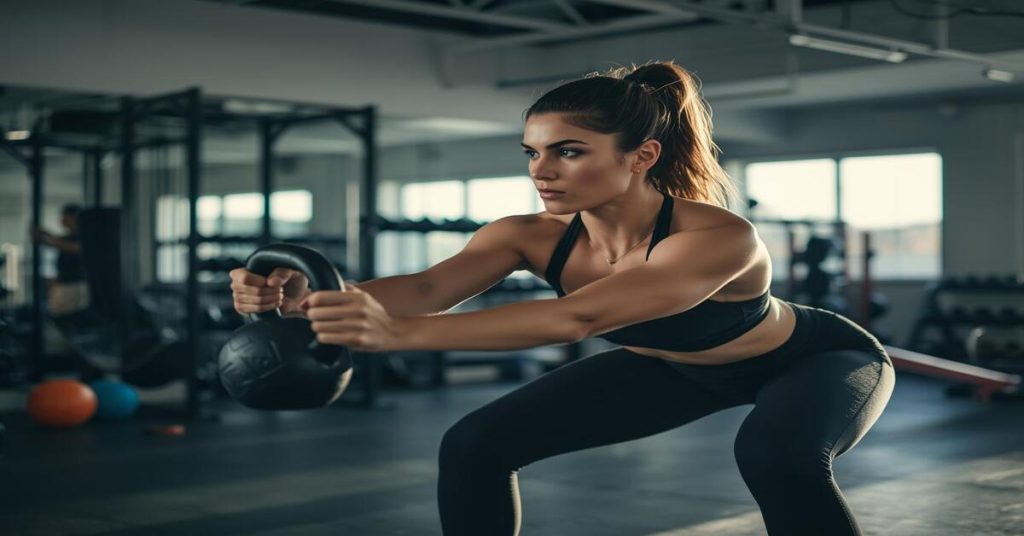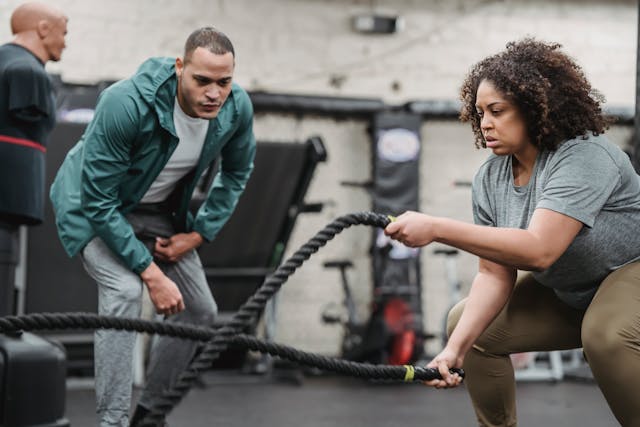Top 20 Functional Fitness Guide for Total Body Strength 💪

Functional Fitness Guide is more than just a trend—it’s a lifestyle. By incorporating these exercises, you train your body to handle real-life movements efficiently, improving strength, balance, and flexibility. Whether you want better posture, injury prevention, or total body strength, this guide offers a holistic approach. 🏋️♂️✨
Why Functional Fitness Matters for Total Body Strength
Everyday movements—like bending, lifting, or twisting—require coordinated muscle action. Traditional workouts often isolate muscles, but Functional Fitness Guide exercises target multiple muscle groups simultaneously. This leads to better stability, stronger core, and enhanced endurance. It also reduces the risk of injuries in daily life. 💡
Read more: Top 10 Best Sports for Fitness — The Ultimate Guide to Stay Strong, Active & Energetic in 2025
Here’s the top 20 Functional Fitness Guide exercises that will transform your body and empower your workouts.
1. Squats with Shoulder Press 🏋️♀️
Squats with shoulder presses combine lower and upper body strength in one movement. Engage glutes, quads, hamstrings, shoulders, and core simultaneously. Begin with moderate dumbbells, squat until thighs are parallel, and push weights overhead as you rise. Enhances mobility and builds total body strength naturally. 💪
2. Deadlifts with Row 🔄
This targets your posterior chain—hamstrings, glutes, lower back, and traps—while also working arms. Combining deadlift with row improves grip strength and spinal stability. Mimics lifting heavy objects, enhancing real-life strength. Maintain a straight back to avoid injury. ✅
3. Kettlebell Swings 🔔
Kettlebell swings are perfect for explosive power and core activation. Swing the kettlebell using hip thrusts, keeping arms relaxed and core tight. Works glutes, hamstrings, shoulders, and cardiovascular endurance. Trains your body to generate power from the hips for real-life tasks. ⚡
4. Push-Up Variations 🔥
Push-ups engage chest, shoulders, triceps, and core. Variations like incline, decline, or diamond push-ups improve upper body strength and shoulder stability. Functional push-ups are easily modifiable for all levels and build strength for daily movements. 💥
5. Lunges with Rotation 🌪️
Lunges with torso rotation combine lower body stability and rotational core strength. Step forward, rotate torso toward the leading leg, engaging obliques. Improves balance and functional mobility. Prevents falls by strengthening stabilizing muscles in hips and legs.
6. Plank with Arm Reach ✋
Hold a plank and slowly extend one arm forward. Engages abs, back, shoulders, and glutes. Incorporating movement into static exercise teaches the body to maintain stability during everyday activities like reaching or pushing objects. 🌟
7. Medicine Ball Slams 💥
Lift the ball overhead and slam to the floor. Targets explosive power and core strength, mimicking real-life actions like throwing. Improves coordination, grip strength, and cardiovascular endurance. Bend knees and engage core for safety.
8. TRX Rows 🪢
Suspension training with TRX engages back, biceps, and core. Instability challenges stabilizing muscles, improving functional strength. Body angle adjustments make it suitable for all fitness levels.
9. Step-Ups with Dumbbells 🪜
Step-ups mimic climbing stairs or elevated surfaces. Holding dumbbells strengthens glutes, quads, hamstrings, and core. Enhances balance and functional lower body strength. 🔑
10. Farmer’s Carry 🚶♂️
Pick heavy dumbbells or kettlebells and walk a distance. Strengthens grip, forearms, shoulders, and core. Prepares body for lifting groceries or moving objects safely. Maintain proper posture. ✅
11. Bulgarian Split Squats 🇧🇬
Single-leg squats improve balance, strengthen glutes and quads, and correct muscle imbalances. Foot on a bench or chair, squat with front leg. Advanced options include dumbbells. Functional for single-leg stability tasks.
12. Battle Ropes 🌊
Dynamic full-body workout. Swing ropes in waves or slams for arms, shoulders, core, and cardiovascular endurance. Trains muscles for explosive repetitive motions. Adjustable intensity for all levels.
13. Stability Ball Rollouts ⚪
Strengthens entire core, including stabilizing muscles. Kneel with forearms on ball, extend body forward, then return. Improves posture, spinal stability, and injury prevention. Functional for daily bending and lifting tasks.
14. Single-Leg Romanian Deadlift 🦵
Emphasizes hamstrings and glutes while enhancing balance. Hinge at hips on one leg. Prevents imbalances and builds functional lower body strength safely. Great for walking, running, or lifting.
15. Pull-Ups & Chin-Ups ⬆️
Strengthens back, biceps, and core. Improves pulling strength for climbing, lifting, or carrying. Variations include assisted bands, weighted, or neutral grip. Consistency enhances upper body performance.
16. Glute Bridges 🍑
Activates glutes, hamstrings, and lower back. Single-leg or weighted variations improve hip extension. Enhances posture, reduces lower back pain, and boosts performance in daily movements.
17. Side Lunges ➡️⬅️
Targets adductors, quads, glutes, and core. Lateral movement often neglected in workouts, but essential for real-life mobility. Dumbbells increase resistance and overall functional strength.
18. Overhead Carries 🎒
Hold weight above head while walking. Strengthens shoulders, core, and grip. Improves balance and stability. Functional for lifting objects onto shelves or moving furniture.
19. Rotational Medicine Ball Throws ⚡
Targets obliques, shoulders, and legs, simulating twisting and throwing. Enhances explosive power, coordination, and core stability. Functional for sports and everyday rotational movements.
20. Burpees with Push-Up & Jump 🏃♂️
Combines squat, push-up, and jump. Builds cardiovascular endurance, strength, and agility. Prepares body for rapid movements, improving overall functional strength. ⚡
Read more: 10 Powerful Fitness Benefits of Playing Badminton That Will Transform Your Health
Advanced Insights & Strategies from the Functional Fitness Guide 💪
In today’s fast-paced world, Functional Fitness Guide is not just about lifting weights or performing exercises—it’s about training your body to handle real-life situations efficiently. When you engage in functional training, you improve joint stability, muscular endurance, and neuromuscular coordination. This allows you to move gracefully, prevent injuries, and enjoy a more active lifestyle. 🌟
Functional fitness emphasizes quality of movement over quantity of repetition. While many people focus on aesthetics, the true essence of a functional fitness routine is mobility, balance, and adaptability. By incorporating dynamic exercises, you ensure your body is prepared for daily life demands, from lifting grocery bags to playing with kids or sports activities. 🏃♂️🏀
The Science Behind Functional Fitness 🧬
When you train with the Functional Fitness Guide principles, multiple muscle groups work together rather than in isolation. Research shows that compound movements improve coordination, enhance core stability, and boost metabolic efficiency. Movements like squats, lunges, and rotational exercises activate stabilizer muscles that are often neglected in traditional workouts. Over time, this leads to improved posture, reduced back pain, and enhanced athletic performance.
Moreover, functional fitness is neurologically enriching. Your brain learns to control muscle activation patterns more efficiently, improving reflexes and reaction times. This is particularly beneficial as we age because it decreases the risk of falls and improves overall body awareness. 🧠💡
Daily Functional Mobility Practices 🌀
In addition to structured workouts, incorporating mobility drills into your daily routine amplifies the benefits of your Functional Fitness Guide program. Consider these practices:
- Dynamic stretching in the morning 🌅: Movements like arm circles, hip openers, and torso twists wake up your muscles and joints.
- Foam rolling & myofascial release 🌀: Relieves tension in the muscles, increases blood flow, and prepares your body for exercise.
- Short micro-sessions during the day ⏱️: 5–10 minutes of squats, push-ups, or planks helps maintain stability, especially for office workers.
By integrating mobility exercises, you maintain flexibility, reduce stiffness, and enhance performance during Functional Fitness Guide workouts.
Core Stability: The Heart of Functional Fitness ❤️
A strong core is the foundation of every functional movement. Core muscles are not just your abs—they include obliques, lower back, glutes, and pelvic floor. Strengthening these areas through exercises like plank variations, rotational twists, and stability ball work ensures that your movements are safe and efficient.
Functional training emphasizes dynamic core activation, which means engaging your core while performing real-life movements. For example, carrying groceries while twisting your torso or bending to pick up objects requires stabilizing muscles to work in harmony. A well-trained core enhances balance, reduces risk of injury, and improves performance in virtually every physical activity. 💪🔥
Cardiovascular Integration in Functional Fitness ❤️🔥
While strength and mobility are crucial, cardiovascular endurance cannot be ignored. Functional Fitness Guide recommends integrating high-intensity interval training (HIIT) with functional movements. Exercises like kettlebell swings, battle ropes, or burpee variations elevate heart rate while working multiple muscles.
This approach provides:
- Fat-burning efficiency 🔥
- Enhanced muscular endurance 💪
- Better oxygen utilization and stamina 🫁
By combining strength and cardio, functional training ensures that your body is ready for both short bursts of energy and sustained daily activity.
Mind-Body Connection in Functional Training 🧘♂️
Functional fitness isn’t just physical—it’s also mental. Each movement requires focus, coordination, and awareness. Practicing mindfulness during exercises, like controlled squats or precision lunges, improves concentration and body awareness.
This mind-body connection strengthens neural pathways that coordinate muscle movement, improving performance in sports, daily activities, and even posture. Over time, your reflexes, balance, and confidence in movement all improve. 🧠✨
Functional Strength for Everyday Life 🏠
The ultimate goal of the Functional Fitness Guide is to prepare your body for real-world demands. Here are examples of how functional strength translates to daily activities:
- Carrying shopping bags 🛍️: Farmer carries build grip, shoulder, and core strength.
- Lifting children or pets 🐶👶: Squats and deadlift variations prepare you for safe lifting.
- Climbing stairs or hills ⛰️: Lunges, step-ups, and single-leg work improve leg endurance.
- Twisting or reaching objects 🔄: Rotational medicine ball exercises enhance obliques and coordination.
By training these patterns, you reduce injury risk, improve efficiency, and gain confidence in everyday life. 🏃♀️💨
Read more: Top 10 Fitness Benefits of Playing Cricket That Will Transform Your Body
Recovery Strategies for Functional Fitness 🛌
Recovery is as crucial as the workout itself. Proper recovery ensures that your muscles repair, adapt, and grow stronger. Consider the following:
- Active recovery sessions 🚶♂️: Light yoga, swimming, or walking promotes blood flow and flexibility.
- Sleep quality 🌙: 7–9 hours of sleep supports muscle repair and hormonal balance.
- Nutrition 🥗: Protein-rich foods, complex carbs, and hydration fuel recovery.
- Mobility drills 🌀: Post-workout stretching prevents stiffness and enhances flexibility.
Progress Tracking & Functional Assessment 📊
Tracking your progress ensures continuous improvement. Use the Functional Fitness Guide principles to monitor:
- Strength gains: Measure weight lifted, repetitions, or endurance time.
- Mobility improvements: Assess flexibility, balance, and range of motion.
- Cardio endurance: Track heart rate response and stamina during HIIT or circuits.
- Functional task performance: Evaluate how easily you perform daily activities.
Regular tracking helps identify weak points, preventing injury and promoting consistent growth. ✅
Functional Fitness Lifestyle Tips 🌱
Beyond the gym, a functional fitness lifestyle promotes holistic health:
- Incorporate movement throughout your day, not just in workouts.
- Prioritize whole foods, hydration, and sleep for optimal performance.
- Engage in activities like hiking, swimming, or sports for fun and fitness.
- Stay mindful of posture and ergonomics at work and home.
Living the Functional Fitness Guide way enhances energy levels, longevity, and quality of life. 🌟
Mental & Emotional Benefits of Functional Fitness 🧠❤️
Functional fitness also benefits mental health. Structured movement improves focus, reduces stress, and increases endorphin release. Mind-body exercises such as yoga, Pilates, or controlled breathing further enhance mental clarity. The combination of physical and mental training makes the Functional Fitness Guide a complete approach to well-being. ✨
Functional Fitness for All Ages 👨👩👧👦
Functional fitness isn’t limited to young athletes. Older adults can benefit significantly by improving balance, strength, and flexibility. Exercises can be modified for mobility, joint limitations, or intensity, making the Functional Fitness Guide adaptable for everyone. Age-appropriate training ensures longevity, independence, and a high quality of life. 🌿
Integrating Functional Fitness Into Daily Routine ⏰
Consistency is key. Short 20–30 minute daily sessions can yield better results than sporadic long workouts. Mix functional exercises with cardio, mobility drills, and core work. The Functional Fitness Guide emphasizes sustainable training habits, so you stay active and fit without burnout. 🏃♂️💨
Functional Fitness Community & Motivation 🤝
Engaging with a fitness community boosts accountability and motivation. Whether online or in-person, sharing your journey, challenges, and progress helps sustain adherence to the Functional Fitness Guide principles. Group workouts, challenges, or accountability partners increase enjoyment and success rates. 💥
Enhancing Daily Performance with the Functional Fitness Guide ⚡
Integrating the principles of the Functional Fitness Guide into your everyday life goes beyond scheduled workouts—it transforms how you move, think, and perform daily tasks. Functional fitness emphasizes efficiency, balance, and joint-friendly strength. Simple activities, when performed with intention, can make a huge difference. For example, squatting to pick up a laundry basket or twisting to reach a high shelf should be controlled and stable, training your body to move safely and effectively. 🏠💪
Functional Fitness in Work & Home Life 🏢🏡
Functional fitness is especially useful for people with sedentary jobs. Sitting for long hours reduces mobility and weakens stabilizing muscles. By incorporating Functional Fitness Guide mini-movements during breaks—like chair squats, standing twists, or calf raises—you maintain circulation, prevent stiffness, and enhance posture.
At home, functional exercises improve daily performance. Carrying groceries, lifting children, or gardening become easier and safer when core and stabilizer muscles are strong. A strong foundation reduces fatigue and allows your body to recover faster from repetitive tasks. 🌿🛒
Balance & Coordination Training 🤸♂️
Balance is a core element of functional fitness. The Functional Fitness Guide emphasizes unilateral exercises, like single-leg deadlifts or side lunges, which train stabilizing muscles and improve coordination. Better balance prevents falls, enhances athletic performance, and boosts confidence in everyday movement.
Using props such as balance discs, BOSU balls, or even a folded yoga mat can introduce gentle instability, challenging your body to adapt and maintain control. Over time, your core and lower body strength improve naturally, making movements like stair climbing, walking on uneven surfaces, or hiking much safer and more efficient. 🌄⚡
Functional Fitness & Mental Sharpness 🧠✨
One often overlooked benefit of the Functional Fitness Guide is its impact on mental sharpness. Exercises that require coordination, stability, and focus stimulate neural pathways, enhancing brain function. Engaging in multi-planar movements or dynamic sequences keeps your mind alert, improving reaction time and problem-solving abilities in everyday life.
Pairing functional exercises with mindfulness—focusing on posture, breath, and controlled motion—reduces stress and improves concentration. This mind-body connection ensures that your fitness journey supports both physical and mental well-being. 🌟🧘♀️
Functional Fitness for Longevity & Injury Prevention 🛡️
Adopting a lifestyle based on the Functional Fitness Guide has long-term benefits. Functional strength training improves joint stability, muscular endurance, and flexibility, reducing the likelihood of injuries in daily life. Unlike traditional isolation exercises, functional training prepares your body for complex movements—lifting, twisting, bending—common in work, hobbies, and sports.
Moreover, maintaining strong muscles around joints protects cartilage and reduces strain. Over time, this approach enhances longevity, preserves mobility, and supports an active lifestyle well into older age. 💪🌿
Combining Functional Fitness with Lifestyle Habits 🌞
The Functional Fitness Guide is most effective when combined with healthy lifestyle habits:
- Nutrition 🥗: Protein-rich foods, antioxidants, and hydration support muscle recovery.
- Sleep 🌙: Adequate rest enhances strength gains and mental alertness.
- Movement variety 🔄: Alternate functional training with cardio, yoga, or swimming to avoid monotony and improve overall fitness.
- Stress management 🧘♂️: Breathing exercises, meditation, or short walks reduce tension and improve performance.
By merging functional fitness with these daily habits, your body becomes more resilient, energized, and capable of handling life’s demands efficiently. 🌟💥
Adapting Functional Fitness for Personal Goals 🎯
Every individual has unique needs. The Functional Fitness Guide can be tailored to different goals:
- Weight management ⚖️: Combine functional circuits with cardio for calorie burn.
- Sports performance 🏀🏈: Enhance agility, power, and reaction time.
- Rehabilitation & mobility 🩺: Gentle functional exercises restore movement patterns after injury.
- Everyday strength 🏠: Ensure daily tasks like lifting, bending, or carrying are effortless and safe.
Personalizing functional fitness ensures long-term engagement and sustainable results, while keeping your workouts challenging and enjoyable. 🎉💪
Read more: 20 Ultimate Fitness and Exercise Guide to Transform Your Body and Mind
FAQs About Functional Fitness Guide ❓
1. What are functional fitness exercises?
Functional fitness exercises train your body to perform real-life movements efficiently, enhancing strength, stability, and flexibility across multiple muscle groups.
2. How often should I do functional fitness workouts?
Aim for 3-5 sessions per week, depending on your fitness level and recovery needs. Include a variety of exercises to target all major muscle groups.
3. Do I need equipment for functional fitness?
Bodyweight exercises are effective, but dumbbells, kettlebells, resistance bands, TRX, and medicine balls enhance intensity and variety.
4. Can beginners start functional fitness exercises?
Absolutely! Beginners can start with bodyweight exercises and gradually incorporate equipment as strength and coordination improve.
Final Thoughts 💡

Functional Fitness Guide exercises are the cornerstone of total body strength, injury prevention, and everyday mobility. Incorporate the top 20 exercises above to train muscles efficiently, improve balance, and gain endurance. Start gradually, focus on form, and increase intensity over time. This guide empowers your body for real-life movements and challenges. 🌟💪
For more tips on building total body strength, check out this Functional Fitness Guide resource on Men’s Health for expert advice. 💪
Discover effective functional workouts and mobility routines at Functional Fitness Guide section on Self to enhance your daily performance. 🌟



Pingback: How to Sleep Better at Night Naturally | Proven Tips 0
Pingback: How Sleep Affects Mental Health | Discover the Powerful Link Today0 🧠
Pingback: Natural Glowing Skin: Proven Tips for Radiant Beauty Naturally0
Pingback: Top 10 Proven Functional Training Exercises for Real-Life Strength & Mobility
Pingback: 100% Full Body Fitness Routine for Total Strength & Health
Pingback: 8-Minute Desk Yoga Stretch Routine to Boost Focus & Reduce Stress
Pingback: 🔥 Ultimate Home HIIT Workout Plan to Burn Fat Fast and Get Fit Quickly 💪100%